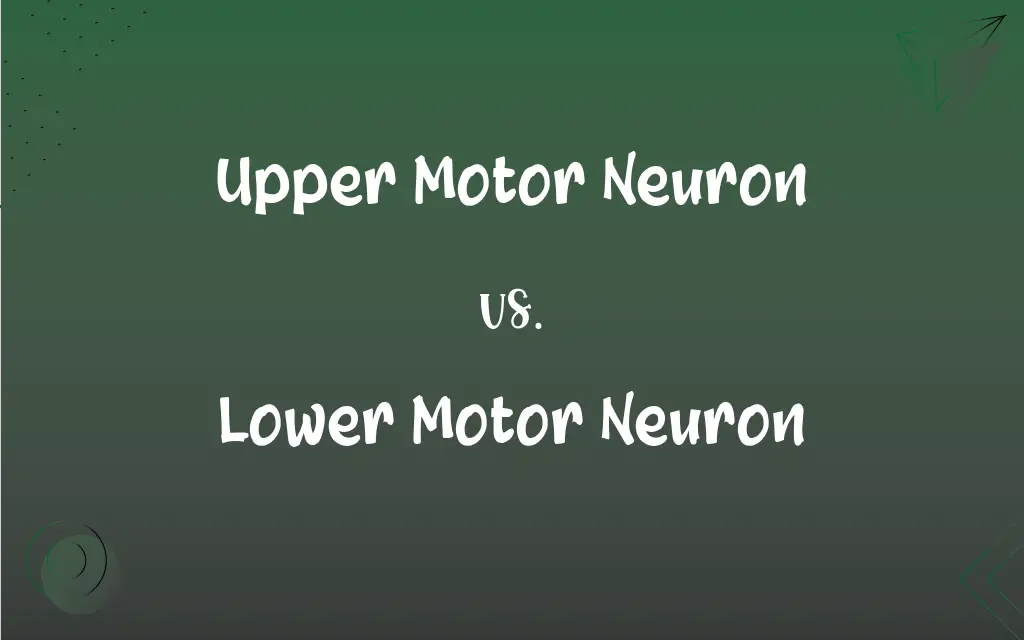Upper Motor Neuron vs. Lower Motor Neuron: What's the Difference?
Edited by Aimie Carlson || By Harlon Moss || Published on February 10, 2024
Upper motor neurons are nerve cells in the central nervous system that control the lower motor neurons; lower motor neurons are nerve cells that directly innervate muscles to facilitate movement.

Key Differences
Upper motor neurons originate in the brain's motor cortex and transmit signals to lower motor neurons, which are crucial for initiating and controlling voluntary movements. Lower motor neurons, found in the spinal cord and brainstem, directly connect to muscles, translating these signals into action.
Upper motor neurons are located in the central nervous system, particularly in the brain's motor cortex, and their axons extend to the spinal cord. Lower motor neurons reside in the anterior horn of the spinal cord or brainstem cranial nerve nuclei, with their axons extending to muscles.
Upper motor neurons are responsible for the planning, initiation, and coordination of movement, as well as modulating sensory input to refine motor actions. Lower motor neurons execute these plans by directly stimulating muscle fibers, resulting in movement.
Damage to upper motor neurons typically results in spastic paralysis, increased muscle tone, and hyperreflexia, due to the loss of inhibitory control over lower motor neurons. In contrast, damage to lower motor neurons causes flaccid paralysis, muscle atrophy, and decreased reflexes, reflecting the direct interruption of muscle innervation.
Diseases affecting upper motor neurons include conditions like stroke and multiple sclerosis, while lower motor neuron diseases include poliomyelitis and amyotrophic lateral sclerosis (ALS), each affecting motor control in distinct ways.
ADVERTISEMENT
Comparison Chart
Location
Central nervous system (brain and spinal cord)
Peripheral nervous system (spinal cord, brainstem)
Function
Initiate and modulate motor commands
Directly stimulate muscles for movement
Pathways
Corticospinal and corticobulbar tracts
Peripheral nerves to muscles
Symptoms of Damage
Spastic paralysis, hyperreflexia
Flaccid paralysis, muscle atrophy
Disease Associations
Stroke, multiple sclerosis
Poliomyelitis, amyotrophic lateral sclerosis (ALS)
ADVERTISEMENT
Upper Motor Neuron and Lower Motor Neuron Definitions
Upper Motor Neuron
They are integral to motor planning and coordination.
Upper motor neuron activity increases during learning new movements.
Lower Motor Neuron
They directly cause muscle contraction and movement.
When you lift an object, lower motor neurons stimulate your arm muscles.
Upper Motor Neuron
Upper motor neurons modulate and refine motor functions.
Upper motor neurons adjust arm movements during precise tasks.
Lower Motor Neuron
Lower motor neurons are impacted in peripheral nervous system diseases.
In ALS, lower motor neuron degeneration leads to muscle atrophy.
Upper Motor Neuron
Upper motor neurons are CNS neurons that control voluntary movement.
Damage to upper motor neurons can result in spasticity.
Lower Motor Neuron
Lower motor neurons connect the spinal cord to muscles.
Lower motor neuron damage can cause muscle weakness.
Upper Motor Neuron
Upper motor neurons are affected in central nervous system disorders.
In multiple sclerosis, upper motor neuron damage leads to coordination issues.
Lower Motor Neuron
Lower motor neurons are the final pathway for motor commands.
Lower motor neurons are essential for executing fine motor skills.
Upper Motor Neuron
They transmit signals from the brain to lower motor neurons.
Upper motor neurons play a key role in initiating walking.
Lower Motor Neuron
They are crucial for reflex actions and voluntary movement.
Reflexive knee jerk is mediated by lower motor neurons.
FAQs
What is an upper motor neuron?
It's a neuron in the CNS that controls voluntary movements.
Where are upper motor neurons located?
In the brain's motor cortex and parts of the spinal cord.
Where do lower motor neurons reside?
In the anterior horn of the spinal cord and brainstem cranial nerve nuclei.
What are the effects of lower motor neuron damage?
It results in flaccid paralysis, muscle atrophy, and decreased reflexes.
What is a lower motor neuron?
A neuron that connects the spinal cord or brainstem to muscles.
What happens if upper motor neurons are damaged?
It can lead to spastic paralysis and increased muscle tone.
What diseases affect upper motor neurons?
Stroke, multiple sclerosis, and cerebral palsy, among others.
Can upper motor neuron damage be reversed?
Depending on the cause, some recovery might be possible, but often there are lasting effects.
How do upper motor neurons influence motor control?
They modulate and refine motor commands for smooth and coordinated movements.
Which diseases impact lower motor neurons?
Poliomyelitis, ALS, and peripheral neuropathies.
Do upper motor neurons directly stimulate muscles?
No, they transmit signals to lower motor neurons, which then stimulate muscles.
Do upper motor neurons have a role in sensory processing?
Indirectly, as they modulate motor responses to sensory input.
Are lower motor neurons involved in reflex actions?
Yes, they directly mediate reflex responses.
What causes muscle atrophy in lower motor neuron syndrome?
The loss of neural connections to the muscle leads to atrophy.
Are lower motor neurons involved in voluntary movements?
Yes, they directly execute the commands for voluntary movements.
Can lower motor neurons function without upper motor neuron input?
They can, but the movement would lack coordination and control.
Is spasticity a sign of upper or lower motor neuron damage?
It's a sign of upper motor neuron damage.
Can upper motor neuron lesions lead to reflex changes?
Yes, typically causing hyperreflexia.
What kind of paralysis is associated with lower motor neuron lesions?
Flaccid paralysis.
Are lower motor neurons replaceable or regenerative?
They have limited regenerative capacity; damage is often irreversible.
About Author
Written by
Harlon MossHarlon is a seasoned quality moderator and accomplished content writer for Difference Wiki. An alumnus of the prestigious University of California, he earned his degree in Computer Science. Leveraging his academic background, Harlon brings a meticulous and informed perspective to his work, ensuring content accuracy and excellence.
Edited by
Aimie CarlsonAimie Carlson, holding a master's degree in English literature, is a fervent English language enthusiast. She lends her writing talents to Difference Wiki, a prominent website that specializes in comparisons, offering readers insightful analyses that both captivate and inform.
































































